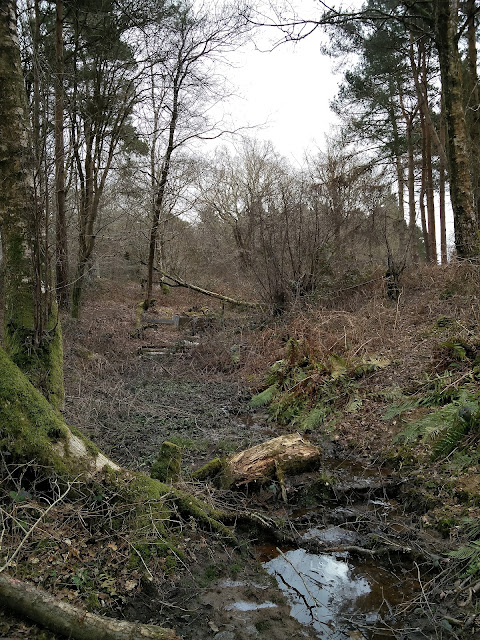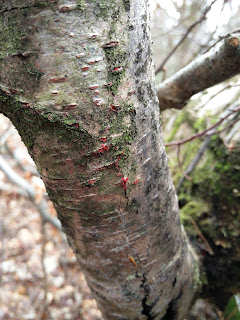 |
| Small stream that runs along the southern edge of the plateau at Park Corner Heath, looking east towards the pond. |
As the Brimstone butterfly emerges from hibernation to patrol the woodland rides, looking for a mate, the Bog Beacon arises also, in the dampest places, to put on its own reproductive display. We saw crowds of them this morning along the stream which borders the southern edge of the plateau at Park Corner Heath (pictured above).
Over the years Butterfly Conservation volunteers have put in several small dams to slow the flow along this stream and create a series of small pools. The work was done primarily to improve the habitat for dragonflies and damselflies, but seems to have also created ideal conditions for Bog Beacon.
 |
| Bog Beacon habitat |
 |
| Bog Beacon doing whatever it is that Bog Beacon does. |
 |
| Wet woodland ride in Rowland Wood, where Bog Beacon occurs. |
Being new to recording fungi, I tend to assume that if *I've* managed to find and identify a species, it's probably something fairly common. So I was surprised to discover that, while this species does feature in the Collins Complete (photographic) Guide, it doesn't get the slightest mention in the Collins (illustrated) Fungi Guide – although the latter does include a selection of "the more common, conspicuous, large, interesting and/or distinctive" ascomycetes.
Well, this looks pretty conspicuous, large and interesting to me – so perhaps it's been left out because it's not very common?
I looked on the British Mycological Society's FRDBI database online and it includes only two records of M. paludosa from East Sussex: One from Vert Wood (part of the same woodland complex as Park Corner Heath & Rowland Wood) in 1967; and one from Chelwood Gate in 1979. But the species must be more widespread than the FRDBI records suggest because Googling "Bog Beacon Sussex" brings up a bunch of other records and photographs of this charismatic species.
Worth sticking the record in then!
For the record
Date: 20/03/2016
Location: Park Corner Heath
Grid reference (for M. paludosa): TQ510147
Location: Rowland Wood
Grid reference (for M. paludosa): TQ514150
Entered into FRDBI: 13/02/2017

















